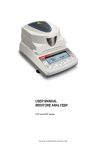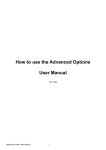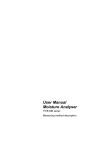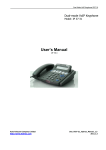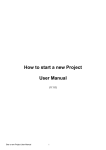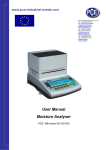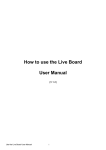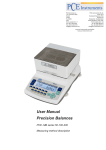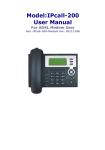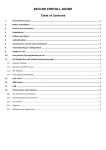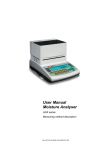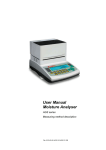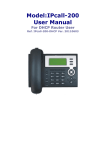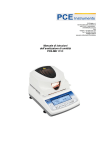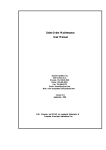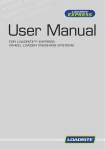Download USER MANUAL MOISTURE ANALYZER
Transcript
PCE Americas Inc. 711 Commerce Way Suite 8 Jupiter FL-33458 USA From outside US: +1 Tel: (561) 320-9162 Fax: (561) 320-9176 [email protected] PCE Instruments UK Ltd. Units 12/13 Southpoint Business Park Ensign way Hampshire / Southampton United Kingdom, SO31 4RF From outside UK: +44 Tel: (0) 2380 98703 0 Fax: (0) 2380 98703 9 [email protected] www.pce-instruments.com/english www.pce-instruments.com USER MANUAL MOISTURE ANALYZER PCE-MB C series 2 USER MANUAL Content: 1. Security rules _________________________________________________________________ 3 2. Set__________________________________________________________________________ 3 3. Navigation – fast start ___________________________________________________________ 4 4. Moisture analyzer menu diagram __________________________________________________ 6 5. General description _____________________________________________________________ 7 6. Technical data ______________________________________ Fehler! Textmarke nicht definiert. 7. Keys and indicators _____________________________________________________________ 8 8. Preparation to work _____________________________________________________________ 9 9. Interfaces ___________________________________________________________________ 12 10. General working rules __________________________________________________________ 12 11. Description of thermogravimetric analysis ___________________________________________ 12 11.1 Infrared radiation source ________________________________________________________ 13 11.2 Infrared radiation drying description _______________________________________________ 13 11.3 Drawing and preparation of a sample ______________________________________________ 13 11.4 Tools requirements ____________________________________________________________ 14 11.5 Single-use pans ______________________________________________________________ 14 11.6 Placing a sample ______________________________________________________________ 14 11.7 Glass fibre filter _______________________________________________________________ 15 11.8 Selection of drying parameters to the sample material _________________________________ 15 11.9 Other practical notes ___________________________________________________________ 16 12. Moisture analyzer start _________________________________________________________ 17 13. Drying parameters settings ______________________________________________________ 18 13.1 Setting drying temperature ______________________________________________________ 19 13.2 Calculation methods ___________________________________________________________ 19 13.3 Drier working modes, drying time, sample time _______________________________________ 20 13.4 Drying profiles ________________________________________________________________ 22 13.5 Moisture analyzer memory ______________________________________________________ 22 13.5.1 Saving settings _______________________________________________________________ 23 13.5.2 Loading saved settings_________________________________________________________ 24 13.6 Initial moisture analysis _________________________________________________________ 25 14. Proper moisture_______________________________________________________________ 27 15. Connecting to a printer or computer – drying report ___________________________________ 28 16. Moisture analyzer options _______________________________________________________ 30 17. Testing and calibration _________________________________________________________ 34 18. Moisture analyser as a balance ___________________________________________________ 35 18.1 Units _______________________________________________________________________ 35 18.2 Auto-zeroing _________________________________________________________________ 36 18.3 Calibration ___________________________________________________________________ 37 19. Maintenance and repairs of small defects ___________________________________________ 39 Declaration of Conformity ____________________________ Fehler! Textmarke nicht definiert. Appendix __________________________________________________________________________ 41 USER MANUAL 3 1. Security rules To avoid electrical shock or damage of the moisture analyzer or connected peripheral devices, it is necessary to follow the security rules below. To feed the analyser use only mains socket with ground contact. Fuse is situated under the analyzer cover. During heating, the halogen heaters warm up to very high temperature. Avoid touching the heaters as it may cause severe burns! Dryer chamber cover heats up to 60°C, but perforated cover at the top may heat up over 100°C. Do not touch the cover top during drying as it may cause severe burns. All repairs and necessary regulations can be made by authorised personnel only. Do not use the analyser when its cover is opened. Do not use the analyser in explosive conditions. Do not use the analyser in high humidity. If the device seems not to operate properly, plug it out of the mains and do not use it until checked by authorised service. Please return wasted device to the point of purchase or other company specialised in recycling of wasted electronic components. According to legal regulations it is forbidden to dispose wasted electronic equipment in waste containers. 2. Set The full set consists of: 1. Moisture analyzer, 2. Pan shield, pan support, pan handle, 3. Single-use pans – 10 pcs., 4. Power supply cord, 5. User manual and guarantee card Option on demand: 6. PT-105 thermometer with GT-105sk-8 probe 7. Distance sleeves 20mm – 2 pieces USER MANUAL 4 3. Navigation – fast start After turning on the moisture analyzer, after autotests and tare, moisture analyzer starts initial heating until the drying chamber heats up to 105°C. The moisture analyzer is now ready to measure density with inscribed earlier heating parameters. To set heating parameters use USER MENU and choose Drying settings. To move cursor between menu positions use and key. 1. Drying settings 2. Memory settings 3. Drying options 4. Drying raport 5. Configuration 6. Settings default Entering chosen menu position is made by using or ENTER key. Return . USER MENU 1. Drying settings 2. Memory settings 3. Drying options 4. Drying raport 5. Configuration 6. Settings default Entrance to parameters is made after choosing or ENTER key. DRYING SETTINGS 1. Drying temp. : 160 C 2. Mode : Time mode 3. Calculation : m0-m/m*100% 4. Samples quantity. : 3 5. Sampling interv. : 1 sek 6. Drying time : 00:15:00s Parameter value modification is made by using and key, moving to another digit by key. Confirmation using ENTER key. DRYING SETTINGS 1. Drying temp. : 160 C 2. Mode : Time mode 3. Calculation : m0-m/m*100% 4. Samples quantity. : 3 5. Sampling interv. : 1 sek 6. Drying time : 00:15:00s ENTER DRYING SETTINGS 1. Drying temp. 2. Mode 3. Calculation 4. Samples quantity. 5. Sampling interv. 6. Drying time Selection of one of the available parameter options is made by and key. Confirmation using ENTER. : 160 C : Time mode : m0-m/m*100% : 3 : 1 sek : 00:15:00s ENTER USER MANUAL 5 Moisture analyzer can work in one of two modes, changed by key: 1) Drying (density measurement) formula evaluation drying profile inscribed drying temperature sample time actual temperature actual drying time mass on pan initial mass closed (CSD) /open(OPN) 2) Weighing (mass measurement) scale stabilization mark mass indication USER MANUAL 6 4. Moisture analyzer menu diagram 1. 2. 3. 4. 5. 6. 7. Drying settings Memory settings Drying options Drying raport Configuration Settings default Exit 1. 2. 3. 4. 5. 6. 7. 8. 9. Drying temp. Mode Calculation Samples quantity Sampling interv. Drying time Drying profile Settings storing Exit 1. Memory locat. 1. Average 2. Drying chart 3. Transmission 4. Temp. correction 5. Exit 1. 2. 3. 4. 5. Product name Operator Remarks Print settings Exit 1. Units 2. Auto-zeroing 3. Interface 4. LCD settings 5. Language 6. Time&Date 7. Keyboard 8. Defaults 9. Calibration 10. Info 11. Exit 1. Date 2. Time 3. Nr 4. Name 5. Drying temp. 6. Profile 7. Mode 8. Method 9. Finished 10. Initial weight 11. Final weight 12. Drying time 13. Sampling int. 14. Moisture 15. Quantity 16. Average 17. Remarks 18. Performance 19. Signature <PL><ENG><DE><ESP><ITA><FRA> USER MANUAL 7 5. General description Moisture analyzers ATS and BTS are designed for fast and precise moisture determination of a sample based on mass loss during heating process. Drying proces parameters are set by user on the basis of law norms, available chemical-physics data or they are matched experimentally. Parameters table for typical materials is contained in the A appendix. Moisture analyzers are designed to work in food industry, construction materials industry, biotechnology, pharmacy, environment protection and others. Main field of use is quality control. USER MANUAL 8 6. Keys and indicators m0-m/m0*100% Td=105C ts= 10s 0.00 % T = 32.23C t =0:00:00s m= 0.000g m0= 0.000g ______________________________________________________________________________________________________________________________________________________________________________________________________________________________________________________________________________________ CSD 00:02:00s CSD CLR I/ MENU CLR START STOP ENTER T Indicators: CSD/OPEN 00:02:00s START ENTER STOP - on / off (standby), - enter to menu, - deleting operation, - switching modes drying/ weighing, - navigation key, - measurement start (drying), - navigation key, - natychmiastowe zakończenie suszenia, - navigation key, - printout (transmission) of the result, navigation key, confirmation / option choice, tare (zeroing) scale, - signalling stabilization of measurement result, - signaling closed/open drying chamber USER MANUAL 7. Preparation to work During heating, the halogen heaters 1 warm up to very high temperature. When drying chamber is opened avoid touching the heaters as it may cause severe burns or damage the heaters! Dryer chamber cover 3 heats up to 60°C, but perforated cover may heat up over 100°C. Do not touch the top cover during drying as it may cause severe burns! 9 10 USER MANUAL 1. Take all contents out of a package: the moisture analyser and packed separately: the tin pan shield, single use pans, the pan handle and the pan support. It is recommended to keep the original scale package in order to transport the moisture analyzer safely in future. 2. Place the moisture analyzer on a stable ground not affected by mechanical vibrations and airflows. 3. Level the moisture analyzer with rotating legs 9 so that the air bubble in water-level 10 at the back of the moisture analyzer is in the middle and the moisture analyser rests on all four legs. 4. Open the drying chamber 3 by lifting it by a grip at the front. Insert the window 13 into chamber cover, edges of the window should be located in the latch grooves 14 (push the window until You hear a “click” from all four latches). 5. Put drying chamber floor board 12 on four position pegs in moisture analyzer cover. Put covering plate 4 on three distance pegs 8. Put carefully pan mandrel 5 into scale mechanism hole. 6. Put on empty single-use pan 7 on grip 6 and using the grip place the single pan on scale’s carrying pan (grip ring 6 will be located inside the plate but due to longer diameter it will not rest on carrying pan 5). 7. Close the moisture analyzer chamber 3 and connect the scale to 230V supply. 8. This will start moisture analyzer autotests and after stabilization zero indication will show up. Moisture analyzer will start initial heating signalled by a proper communicate on the screen. After initial heating moisture analyzer is ready to work. USER MANUAL 11 Removing the glass (to clean or remove radiators): 1. Open the moisture analyzer chamber. 2. Raise glass 13 until it will be released from lower glass supports 14 . 3. Remove the glass by diverting lower limb (look at the picture above). When temperature during initial heating exceeds 105°C or heating time is longer than 3 minute, terminate initial heating with STOP key and check if the temperature sensor 2 works properly and if both halogen heaters light 1 (see chapter 15). In case any defect occurs contact an authorised service point. 4. Moisture analyzer shouldn’t be used to weigh ferromagnetic materials due to deterioration of measurement precision. The fuse 11 is available after cover opening and putting out floor board 12. During damaged fuse exchange use a fuse with parameters presented in technical data (ch. 6). Using other fuse may cause electrical shock. USER MANUAL 12 8. Interfaces The moisture analyser is equipped with RS23C interface to connect a printer or a computer and with PS2 port to connect an external computer keyboard. RS232C 1 RxD (receive) TxD (transmission) 2 3 4 mass 5 USB PS2 Clock 6 7 8 9 +5V housing 6 5 4 3 2 1 GND Data 9. General working rules During transportation remove the pan, the pan support and the pan shield and place it in a separate package.. 1. Distribute a sample all over the pan. A sample surface should not touch temperature sensor placed above the pan. 2. The balance is equipped with the tare equal to its range. To tare the balance press T key. Writing the tare does not extend measuring range, but only subtracts the tare value from a load placed on the pan. To make weight control easier and to avoid range overdrawing, the balance is equipped with weight indicator (graduated in percentages). 3. Do not overload the moisture analyzer more then 20% of maximum load (Max). 4. The mechanism of the moisture analyzer is a precise device sensitive to mechanical strokes and shocks. Do not press the pan with a hand. 10. Description of thermogravimetric analysis This section gives some practical details about moisture analysis using infrared radiation for reliable results and easier use of moisture analyser. The description is based on a pre-production experience and customers’ suggestions. USER MANUAL 13 Moisture in substances is an essential quality factor of technical and economical importance. Methods of determining moisture may be grouped in two main categories: absolute and deductive. Absolute methods are based on simple relations, e.g. weight decline during drying. Thermogravimetric analysis used in PCE moisture analyser is an example of this method. Deductive (indirect) methods measure physical quantity related with moisture, e.g. electromagnetic waves absorption, electrical conductance, acoustic wave speed. Some of these methods, unlike thermogravimetric analysis, enable to determine water content. Thermogravimetry - lat. thermo – heat, gravi – weight, metry – method Thermogravimetric analysis – a process of determination of a substance mass decline as a result of heat-up. The sample is weighed before and after heating-up, the difference is calculated in relation to initial weight or final weight (dry mass). Moisture in substances Thermogravimetric analysis includes all ingredients evaporating from substances during heating-up, which results in weight decrease. In result of the above, determining of moisture content in substances is not equal water content. Beside water, moisture consists of all other volatile matter: fats, alcohol, aromas, organic dissolvent and other substances resultant as en effect of thermal decomposition. Thermogravimetric analysis does not distinguish water from other volatile matters. Infrared radiation drying is more effective than traditional methods (e.g. in an oven) as the radiation deeply penetrates the substance, which shortens drying time. 11.1 Infrared radiation source ATS/BTS series moisture analyser uses 2 halogen heaters (rated power 100W, l=78mm) in serial connection as a radiation source. The heaters emit also visible radiation, which does not affect drying process. 11.2 Infrared radiation drying description Sample drying is a result of absorption of infrared radiation, which results in sample temperature increase and evaporation of volatile matters. Infrared radiation penetrates surface layers, the depth depends on penetrability of a sample (different in various substances). Part of radiation is reflected by the sample surface. Penetrated layers absorb the radiation and convert its energy into heat. Emitted heat propagates inside the sample. Effectiveness of the propagation depends on thermal conductivity of the sample. The better the conductivity, the faster drying process and volatile matter evaporation. During drying process sample parameters change, its thermal conductivity decreases so there is a risk of burning the sample. Some parameters may be estimated “by sight”, e.g. smooth and light surfaces reflect radiation better. This must be taken into account when setting drying parameters. 11.3 Drawing and preparation of a sample As sample of given substance must be representative, drawing and preparing a sample is very important process as it affects repeatability of measurements. The most common USER MANUAL 14 method of homogenizing a sample is mixing. The other method is to draw few samples from different but specific points in a substance and calculate an average value. Another – to draw few samples from different points in a substance, mix them and draw a sample from the mixed samples. Sampling method depends on the object of a research. For quality purpose many representative samples are analysed. In production control it is enough to assure sampling repeatability, which enables to study a tendency. While preparing and drawing, it is important that the sample does not absorb moisture from the environment – it is advised that operation time is as short as possible. If it is necessary to analyse more than one sample at the same time, the samples should be closed in plastic bags or other isolated containers. Give attention that samples must not lose moisture inside the container (the container should not consist of to much air, the moisture condensed on the sides of the container should be mixed with the sample again). 11.4 Tools requirements Tools and instruments used in preparation process may affect measurement accuracy, so it is advised not to use tools that transmit heat, as it makes the sample lose moisture before analysis. Use only special mills and pestles. In case of liquids with consisting of solid materials use a glass mixer, a spoon or a magnetic mixer. 11.5 Single-use pans To analyse the moisture, put a sample on a single-use pan and place it in the dryer chamber. Using non-reusable pan helps to avoid false results by remains of previous samples. 10 single use pans are provided with the moisture analyser. Any quantity may be delivered on demand. 11.6 Placing a sample A sample should be placed uniformly all over the pan, so that heat propagates equally all over the sample and dries whole sample effectively and quickly without leaving “wet” places. Correct Incorrect USER MANUAL 15 Attention: Due to temperature sensor localisation, max sample height is 10mm. When substance ply is too thick, surface layers will be heated too much and internal – not enough. This may result in burning the sample or surface incrustation, which will make drying process difficult and measuring result false. A sample should be placed in uniformed layers 1÷3mm thick, weighing 1÷10g, depending on a substance. 11.7 Glass fibre filter When drying liquids, pastes or substances that may melt or loose liquid during drying, it is advised to use glass fibre filters. Filters ensure equal liquid distribution or, in case solid materials, avoiding burning a sample. 11.8 Selection of drying parameters to the sample material Selection of proper temperature and drying time is essential to achieve precise humidity measurement. Drying parameters are selected properly if repeatability is on satisfactory level, usually between 0,11%. Parameters choice should be made in 3 steps: Step 1: Drying temperature is related to the physico-chemical properties of the sample. It is determined by the number of tests carried out in several successive temperatures, e.g., at intervals of 10 ° C. Proper temperature is the highest value for which the sample for a few minutes does not change color and smell. Changing the color or odor indicates the start of the oxidation of the sample, which changes the properties of the sample, which usually affects the measurement accuracy. Step 2: Weight of sample used should be large enough to use the entire surface of the pan, however, the thinner the layer of sample the better the drying process proceeds. The top and bottom layers of the material should be dried similarly at the same time. If the material is covered with shell and some moisture is trapped in the material, user should disintegrate the material or reduce the drying temperature. For liquid materials is preferable to use filter which accelerates the drying. Step 3: Select drying time to chosen mass of sample. To do this, set the moisture analyzer’s drying time as long as possible and observe the drying process. Minimum drying time is the one at which the sample doesn’t change its weight by more than allowed by the examiner measurement error. Proper drying time is designated minimum drying time with reserve. The percentage value of the reserve must exceed the mass of the sample dispersion - the drying sample time is proportional to the mass of the sample. After a few measurements with the designated drying parameters and making sure that the reproducibility of the results is satisfactory user can proceed to optimize the measurement time by selecting favorable Drying profile and using Short measurement mode. Of course you should check that the reproducibility of the results was not seriously affected. 16 USER MANUAL Sample values for the most common materials are given in the Appendix, however, be regarded only as preliminary data and it is recommended to carry out the procedure for parameters selection for the test material. 11.9 Other practical notes It is preferable to work with the same mass of the sample at each measurement to measure the size of the sample in a reproducible way. It is best to use the same instruments for the application of the sample. Put a sample on the pan as quickly as possible to avoid losing moisture. Temperature inside the chamber is much higher than outside, so the sample may evaporate partly before measurement begins, which will result in a false result. When analysing the same substance quantity in successive measurements, use the same tools to put a sample to be sure that samples are each time of the same size. Before putting a sample, tare a single-use pan and take it out of the chamber. Right after putting a sample on the pan, place it inside the analyser chamber, close the chamber and press START. Be sure that no dirt sticks under the pan, as it may increase sample weight and result in false values. USER MANUAL 17 12. Moisture analyzer start After switching-on the moisture analyser proceeds with self-tests and displays company logo. Next the moisture analyzer is taring (- - - - - -). After taring initial heating starts in order to create proper conditions inside drying chamber. m0-m/m0*100% Td=105C ts= 10s T= 32.23C m=0.000g INITIAL HEATING … Initial heating should warm the drying chamber up to 105°C within 3 minute. When temperature during initial heating exceeds 105°C or heating time is longer than 3 minute, terminate initial heating with STOP key and check if the analyser is not damaged (see chapter 15). After initial heating is completed (or terminated), the device displays the following information: m0-m/m0*100% T = 32.23C t =0:00:00s m= 0.000g m0= 0.000g CSD Td=105C ts= 10s 0.00 % 00:02:00s Legend: m0-m/m0*100% - formula used to calculate the moisture Td – defined drying temperature ts – defined sample drying time T – current temperature in the drying chamber m – current weight, t – current drying time m0 – initial weight - Graphical marking of drying profile CSD – closed cover indication (centrally in lower line) – inscribed drying time 18 USER MANUAL 13. Drying parameters settings In order to achieve proper density measurement results following parameters should be set: - Drying temperature (to 160oC), - Mode : time mode (ends after inscribed time) or short mode (ends after fulfilling drying criterion), - Calculation method – humidity calculation formula, - Samples quantity (only for short mode), - Sampling interval – interval between successive mass measurements (1180s.), - Drying time (1s.10h) (in short mode it’s the maximal drying time), - Drying profile (standard, slow, step or fast), - Settings storing– number of place in memory (110), where the setting will be stored. In case of choosing short mode additionally set: - Samples quantity (2, 3, 4 or 5) – the decisive quantity concerning drying ending. During setting parameters use navigation keys and ENTER key according to description in Navigation. In order to save settings (also after turning off the scale from supply), use Exit option after making all changes. USER MANUAL 19 13.1 Setting drying temperature During setting drying temperature set successively values of individual digits. USER MENU 1. Drying settings 2. Memory settings 3. Drying options 4. Drying report 5. Configuration 6. Settings default 7. Exit DRYING SETTINGS 1. Drying temp. : 60C 2. Mode : short mode 3. Calculation : m0-m/m0*100% 4. Samples quantity : 2 samples 5. Samplingkowania: DRYING SETTINGS 10s 6. Drying timeenia : 0:00:10s 7. Drying profileil suszenia......: wolny 20C 1. Drying temp. : 8. Settings storing ustawień : 1 short mode 2. Mode : Exit 3. Calculation : m0-m/m0*100% DRYING SETTINGS 4. Samples quantity : 2 samples 5. Samplingkowania: 10s 1. Drying temp. : 160C 6. Drying timeenia : 0:00:10s 2. Mode : short mode 7. Drying profileil suszenia......: wolny 3. Calculation : m0-m/m0*100% 8. Settings storing ustawień : 1 4. Samples quantity : 2 samples Exit 5. Sampling: 10s 6. Drying time : 0:00:10sSETTINGS DRYING 7. Drying profile : wolny 8. Settings storing : 1. Drying temperature 1 : 120C Exit 2. Mode : short mode 3. Calculation : m0-m/m0*100% 4. Samples quantity : 2 samples 5. Sampling : 10s 6. Drying time : 0:00:10s 7. Drying profile : slow 8. Settings storing : 1 Exit USER MANUAL 20 13.2 Calculation methods Humidity may be calculated upon the basis of various mathematic formulas, defined in balance – drier as Calculation method: 1. Relative humidity, defined in relation to initial mass w [%] = m0-m/m0*100% , where m0 – initial mass, m- current mass 2. Relative humidity, defined in relation to current mass w [%] = m0-m/m*100% , 3. Percent current mass content in sample w [%] = m/ m0*100% . USER MENU 1. Drying settings 2. Memory settings 3. Drying options 4. Drying report 5. Configuration 6. Settings default DRYING SETTINGS 7. Exit 1. Drying temperature : 120C 2. Mode : short mode 3. Calculation : m0-m/m0*100% 4. Samples quantity : 2 samples 5. Sampling : 10s DRYING SETTINGS 6. Drying time : 0:00:10s 7. Drying profile slow 1. :Drying temperature : 120C 8. Settings storing : 1 2. Mode : short mode Exit 3. Calculation : m0-m/m0*100% 4. Samples quantity : 2 samples 5. Sampling : 10s DRYING SETTINGS 6. Drying time : 0:00:10s 7. Drying profile : Drying slow 1. temperature : 120C 8. Settings storing : 2. Mode 1 : short mode Exit 3. Calculation : m0-m/m0*100% 4. Samples quantity : 2 samples 5. Sampling : 10s 6. Drying time : 0:00:10s 7. Drying profile : slow 8. Settings storing : 1 Exit USER MANUAL 21 13.3 Drier working modes, drying time, sample time During the balance – drier operation sampling of the mass on the pan takes place. Sampling time is set by the user, according to drying process speed. As a result of sampling the current humidity value is calculated and displayed. Measurement is finished depending on selected Drying mode: 1. In Time mode total humidity measurement time (Drying time) is defined by the user, 2. In Short mode humidity measurement is finished, when drying is stopped and differences of a few successive mass samples are smaller than threshold value (2 mg). Amount of successive samples taken into consideration is defined as Samples quantity. Measurement is finished when Drying time is exceeded at the latest. <2mg m Stop >2mg Start Ts t Qualifying amount (3 samples) Drying chart in Short mode for Samples quantity = 3. When choosing time mode only drying time and for example 10 times shorter sample time is needed to start. In Short mode additionally Samples quantity is needed and Samples interval should be carefully calculated – end of drying is based on this parameter(and on Samples quantity). USER MENU 1. Drying settings 2. Memory settings 3. Drying options 4. Drying report 5. Configuration 6. Settings default 7. Exit DRYING SETTINGS 1. Drying temperature 2. Mode 3. Calculation 4. Samples quantity 5. Sampling 6. Drying time 7. Drying profile 8. Settings storing Exit : 120C : short mode : m0-m/m0*100% : 2 samples : 10s : 0:00:10s : slow : 1 USER MANUAL 22 13.4 Drying profiles Drying profile will be used to optimization of drying process by accommodation a process to physical properties of sample material. Oxidized materials or thickening on the surface need slow or step profile. Resistant materials can use fast profile . The choice of profile and his parameters should be a result of experience with examinated material. DRYING SETTINGS 1. Drying temperature 2. Mode 3. Calculation 4. Samples quantity 5. Sampling 6. Drying time 7. Drying profile 8. Settings storing Exit : 120C : short mode : m0-m/m0*100% : 2 samples : 10s : 0:00:10s : standard : 1 After choosing a profile set proper parameters for example t1 and T1. DRYING PROFILE Drying profile T=120C Exit : T Attention: Final drying temperature is inscribed only in Standard profile or in Drying setting (main menu). <standard> 120C t DRYING PROFILE Drying profile t1=100s Exit : T <slow> 120C t1 t DRYING PROFILE Drying profile : <step> t1=100s T T1=60C t2=100s 120C T2=90C Exit t1 t2 t DRYING PROFILE Drying profile : t1=100s T1=140C T Exit 140C <fast> T1 t1 t USER MANUAL 23 13.5 Moisture analyzer memory The moisture analyser enables to save 20 different drying settings. Saved settings are kept in the memory even after unplugging moisture analyzer from the mains. 13.5.1 Saving settings In order to store a few settings follow the instructions below: Set the necessary drying settings (as mentioned earlier), choose Settings storing and choose memory cell, where the sets will be saved. USER MENU 1. Drying settings 2. Memory settings 3. Drying options 4. Drying report 5. Configuration 6. Settings default DRYING SETTINGS 7. Exit 2. Mode : time mode 3. Calculation : m0-m/m0*100% 4. Samples quantity : 2 samples 5. Sampling : 10s 6. Drying time : 0:00:10s 7. Drying profile : standard 8. Settings storing : 1 Exit DRYING SETTINGS 2. Mode 3. Calculation 4. Samples quantity 5. Sampling 6. Drying time 7. Drying profile 8. Settings storing Exit : time mode : m0-m/m0*100% : 2 samples : 10s : 0:00:10s : standard : 1 DRYING SETTINGS Save settings? NO YES DRYING SETTINGS Saving . . . USER MANUAL 24 13.5.2 Loading saved settings In order to call earlier settings saved in memory, You enter the menu and choose option Memory settings and choose memory cell number where settings where earlier made. USER MENU 1. Drying settings 2. Memory settings 3. Drying options 4. Drying report 5. Configuration 6. Settings default 7. Exit MEMORY SETTINGS Memory locat.: Settings: <1> Time mode m0-m/m0*100% IK = wyłączone Ts = 45C ts = 0:05:45s tp = 10s MEMORY SETTINGS Memory locat.: Settings: Time mode m0-m/m0*100% IK = OFF <1> Td = 45C ts = 0:05:45s tp = 10s USER MANUAL 25 13.6 Initial moisture analysis To determine optimal drying parameters for unknown sample, it is recommended to perform initial measurement with activated drying chart displaying. To do this, set the following drying parameters (see Drying parameters setting): - Operation Mode: Time mode - Calculation method: m0-m/m0*100% - Drying temperature: organic substances: 80 - 120 0C inorganic substances: 140 - 160 0C - Samples quantity: do not set - Sampling interval: 1 second - Drying time: set time, after which the sample will be definitely dried More information regarding temperature and drying time in A appendix. To activate displaying of drying chart, which will be visible on the display instead of humidity indication, perform the following actions: USER MENU 1. Drying settings 2. Memory settings 3. Drying options 4. Drying raport 5. Configuration 6. Settings default 7. Exit DRYING OPTIONS 1. Average 2. Drying chart 3. Transmission 4. Exit Tare the moisture analyzer with empty single-use pan (T key). Put a sample of examinated material on single-use pan, put it into drying chamber and press START key. USER MANUAL 26 After measurement a drying graph will show up: m0-m/m0*100% Td=120C ts= 0:10:00s T = 118.34C 30% t =0:00:00s m= 1.020g m0= 1.020g Observing drying process chart it is possible to evaluate its course and define time required for complete drying. The chart shows 160 time samples on the X axis (for longer times chart is scaled to 360 samples, 720, etc.) and humidity value according to selected formula on the Y axis (chart is automatically scaled to 10%, 30%, 50%, etc.). Selecting 1 s of sampling time allows for more precise chart. Achieved chart allows for initial settings selection for main measurement. Drying temperature should be selected according to dries material type, so the drying is performed quickly and sample does not change colour. Material drying moment is visible on the chart as drying characteristic bending. As Drying time for main humidity measurement select time from the beginning to chart “flattening”. As the time axis is not described on the chart, use “evaluation with high margin”. Too short drying time does not allow to achieve precise humidity measurement results. In case of Short mode, in main measurement select Sampling time, which allows to include approx. 10 samples in time of characteristic bending. If drying is finished too quickly, increase Samples quantity or Sampling time. Notes: 1. Before main measurement remember about deactivating of chart displaying. 2. To improve operation it is possible to use Promas software (available on demand), which generates precise drying chart. USER MANUAL 27 14. Proper moisture Before measurement carefully prepare the sample (as described in chapter Description of Thermogravimetric Analysis) and set correct drying parameters (see the diagram in chapter 11.6, description of the way of settting is in 11.4). m0-m/m0*100% Td=120C T = 80.23C t =0:00:00s m= 1.020g m0= 1.020g CSD ts= 1sek 0.00 % 00:02:00s Place an empty single-use pan and tare the balance with T key. The indication should be m=0,000g. Open the drying chamber and using the pan handle place the single-use pan with the sample on the pan support. Close the chamber. START m0-m/m0*100% Td=120C 0.00 % T = 80.23C t =0:00:00s m= 1.020g m0= 1.020g CSD m0-m/m0*100% T = 80.23C t =0:00:00s m= 1.020g m0= 1.020g CSD ts= 1sek 00:01:29s nr Td=120C drying/sample ts= 1sek 1.00 % 00:01:29s Start the measurement choosing START key. In the lower line the time left to end the measurement and successive measurement number is displayed. Drying in progress is signalised with alternating SAMPLE /DRYING communicate. Wait until END communicate appears. Now read the result. end Attention: No STB communicate and m0 sign in negative, marks acceptance of unstable initial mass value m0, caused by pressing the pan to chamber wall or by too fast sample drying, which can cause to measurement failures. USER MANUAL 28 15. Connecting to a printer or computer – drying report When drying process is finished measurement result can be send to printer or a computer via RS232C interface after using key. Measuring data can be also completed with text information. To enter text descriptions user can use moisture analyzer keys or connect a computer keyboard to PS2 port at the back of the device. Using computer keyboard enables to control all scale functions. Using navigation keys and ENTER key choose Drying chart and disable or enable printing and displaying the chart. Set necessary options: Product name, Operator and with the connected computer keyboard enter text information for printed report( maximally 19 signs). The set of available signs is presented on next site. Option Remarks is designed to inscribe bigger amount of text using computer keyboard. USER MENU 1. Drying settings 2. Memory settings 3. Drying options 4. Drying report 5. Configuration 6. Settings default 7. Exit DRYING REPORT 1. Product name 2. Operator 3. Remarks 4. Print settings 5. Exit : : PRINTOUT 1. Date 2. Time 3. Nr 4. Name 5. Drying temp. 6. Profile 7. Mode 8. Method 9. Finished 10. Initial weight 11. Final weight 12. Drying time 13. Sampling int. 14. Moisture 15. Quantity 16. Average 17. Remarks 18. Performance Wyjście USER MANUAL 29 Using moisture analyzer keyboard user can inscribe signs: 0, 1, 2, 3, 4, 5, 6, 7, 8 and 9 (only digits). A set of characters available using computer keyboard (PS2) while you use Product name, Operator or Remarks: 1 . , ’ ? ! ” - ( ) @ / : _ ; + & % * = < > $ [ ] { }\ ~ ^ ‘ # | 2ABCabc 3DEFdef 4GHIghi 5JKLjkl 6MNOmno 7PGRSpgrs 8TUVtuv 9WXYZwxyz 0 space Erasing the mark and move the cursor to the left: the navigation key or BackSpace (computer keyboard). To print the drying report press key. Drying started: - - - - - - - - - - - - - - - - - - -- - - - Date: Time.: Serial number: Drying parameters - - - - - - - - - - - - - - - - - - -- - - - Product Drying temperature : Drying profile : Mode : Calculation : Finished : Initial weight Final weight Drying time Sampling interval: Moisture : : : : : NOTE: The analysis performed by: Signature .................................... It is possible to set necessary serial port parameter values (default settings:8bit, 1stop, no parity, 4800bps). To use RS232C Settings option press key (weighing mode) and pres MENU key. Moisture analyzer is equipped with RS232C, USB or Wi-Fi interface. Required drivers and manual can be found on CD disc added to scale. USER MANUAL 30 16. Moisture analyzer options Moisture analyzer options: - quantity of measurements () and average from series of humidity measurements displaying (X), USER MENU 1. Drying settings 2. Memory settings 3. Drying options 4. Drying report 5. Configuration 6. Settings default 7. Exit DRYING OPTIONS 1. Average 2. Drying chart 3. Transmission 4. Temp.correction 5. Exit AVERAGE 1. Status 2. Erasing 3. Exit m0-m/m0*100% Td=120C ts= 1sek T = 80.23C t =0:00:00s m= 1.020g m0= 1.020g 00:02:00s CSD Σ 000 X= 0.00% - drying chart displaying USER MENU 1. Drying settings 2. Memory settings 3. Drying options 4. Drying raport 5. Configuration 6. Settings default 7. Exit DRYING OPTIONS 1. Average 2. Drying chart 3. Transmission 4. Temp. correction 5. Exit m0-m/m0*100% T = 118.34C 30% t =0:00:00s m= 1.020g m0= 1.020g Td=120C ts= 0:10:00s USER MANUAL 31 - transmission of all successive weight measurements (samples) by serial connection (measurements are printed or saved on computer using PROMAS software). USER MENU 1. Drying settings 2. Memory settings 3. Drying options 4. Drying raport 5. Configuration 6. Settings default 7. Exit DRYING OPTIONS 1. Average 2. Drying chart 3. Transmission 4. Temp. correction 5. Exit TRANSMISSION 1. Status: 2. Exit <ON> - correction of moisture analyzer internal thermometer indications based on measurement of two different temperatures, it is suggested to use the highest and lowest temperature set by user, for example 70 oC and 100 oC ; USER MENU 1. Drying settings 2. Memory settings 3. Drying options 4. Drying raport 5. Configuration 6. Settings default 7. Exit DRYING OPTIONS 1. Average 2. Drying chart 3. Transmission 4. Temp. correction 5. Exit TEMP. CORRECTION 1. Moisture temp. T1 = 2. Control temp. T1= 3. Moisture temp. T2 = 4. Control temp. T2= 5. Status <ON> 6. Exit Conditions: - T2-T1 >25 oC - T1 and T2 < 160 oC If the conditions are unfulfilled during changing status to ON communicate Error ! will be displayed. The largest possible to correct difference between internal and external thermometer indications is 20° C. Recommended thermometer type: PT-105 with GT-105 probe. USER MANUAL 32 The way of entering control thermometer probe to moisture analyzer drying chamber: 2 3 100 o C 1 1 – control thermometer probe 2 – distance sleeves 2x10mm (2 sleeves ensure that position of control thermometer probe is the same as moisture analyzer internal temperature sensor) 3 – moisture analyzer internal sensor Before executing temperature correction (inscribing T1 and T2 temperature) drying cycle must be made with inscribed T1 temperature and drying time 15 minutes. It is suggested to put the material sample on the pan. At the end of drying process write down moisture analyzer temperature indication ( T value on the left side of moisture analyzer display) and control thermometer indication. Both indications are needed for correction: TEMP. CORRECTION 1. Moisture temp. T1 = 2. Control temp. T1= 3. Moisture temp. T2 = 4. Control temp. T2= 5. Status <ON> 6. Exit Subsequently make drying cycle for T2 temperature (drying time as above 15 minutes) and write down indications again. This way both T2 indications are inscribed: TEMP. CORRECTION 1. Moisture temp. T1 = 2. Control temp. T1= 3. Moisture temp. T2 = 4. Control temp. T2= 5. Status <ON> 6. Exit USER MANUAL 33 Attention: Moisture analyzer internal thermometer correction is made with internal thermometer and control thermometer on the same level above the sample. The temperature indicated by thermometer situated on some level above the sample can differ from real temperature of the sample. In this case if there is a need for temperature indication correction simply lower the level of control thermometer by removing distance sleeve (picture on page 31 position 2). Put on the pan a layer of material sample with determined thickness and perform correction (description on previous page). During correction thermometer can’t touch the sample. Correct: Uncorrect: 34 17. Testing and calibration USER MANUAL To check the weighing function of balance – drier, switch it to the simple weighing ( key) and check it by putting precisely weighed object, e.g. calibration weight F2 (OIML), equal to device measurement range. In case of any inaccuracies perform the balance calibration. It is performed by activating the calibration function, available in special functions menu, and putting the calibration weight on the pan according to indications on the display (see Sensitivity calibration function). Control of humidity measurement precision requires use of standard substance – disodium tartrate (di-Sodium tartrate dihydrate C4H4Na2O6*H2O). For the control use 5 g sample, setting: quick mode, calculations method: m 0-m/ mo *100% , temperature 150oC, sampling time 10 s, samples amount 4 and drying time 00:15:00s. The result should be contained in range 15.61 – 15.71%. USER MANUAL 35 18. Moisture analyser as a balance The moisture analyser may be also used as a normal balance. To switch between analyser / weighing mode press key. During moisture analyzer work as a normal balance essential influence on measurement result has the proper setting of moisture analyzer level (level indicator is at the back of the device) and precise balance calibration. Setting balance level is important after each putting moisture analyzer into new place . During normal weighing Menu key opens directly Configuration window, where the Units option is available, Auto-zeroing, scale calibration and default settings. 18.1 Units In order to change the unit used in balance and moisture analyzer use MENU key, in Configuration window (User Menu window shows up when the normal weighing mode is off). USER MENU 1. Drying settings 2. Memory settings 3. Drying options 4. Drying report 5. Configuration 6. Settings default 7. Exit CONFIGURATION 1. Units 2. Auto-zeroing 3. Interface 4. LCD settings 5. Language 6. Time&date 7. Keyboard 8. Defaults 9. Calibration 10. Info Exit CONFIGURATION Carat Miligram Gram Kilogram Pound Ounce Ounce troy Grain Pennyweight Newton Exit Choice of unit is made using navigation keys and ENTER key. [ct] [mg] [g] [kg] [lb] [oz] [ozt] [gr] [dwt] [N] USER MANUAL 36 18.2 Auto-zeroing Auto-zeroing function causes that the close to zero indication will be corrected automatically and when the pan is unbiased zero indication will be hold independently even when environment conditions change (temperature, air density etc). USER MENU 1. Drying settings 2. Memory settings 3. Drying options 4. Drying report 5. Configuration 6. Settings default 7. Exit 1. Units 2. Auto-zeroing 3. Interface 4. LCD settings 5. Language 6. Time&date 7. Keyboard 8. Defaults 9. Calibration 10. Info Exit CONFIGURATION AUTO-ZEROING 1. Status: 2. Exit OFF AUTO-ZEROING 1. Status: 2. Exit <ON> <OFF> In order to turn on Auto-zeroing function use navigation keys and ENTER key, choose Status ON. USER MANUAL 37 18.3 Calibration Calibration with external weight standard should be performed in case indications exceed permissible error (for example more than 5 graduation overflow). To scale calibration use weight standard presented in technical data table (or more precise). Depending on the value of gravity acceleration the producer sets the scale to specific location of use. If the location of use change the scale should be calibrated once again Attention: Scale sensitivity error doesn’t cause directly humidity error thanks to percentage calculation formula. In order to calibrate the balance use MENU key and Configuration option, and then Calibration. USER MENU 1. Drying settings 2. Memory settings 3. Drying options 4. Drying raport 5. Configuration 6. Settings default 7. Exit CONFIGURATION 1. Units 2. Auto-zeroing 3. Interface 4. LCD settings 5. Language 6. Time&date 7. Keyboard 8. Defaults 9. Calibration 10. Info Exit CALIBRATION 1. Calibration: 2. Load : 3. Exit 100g CALIBRATION 1. Calibration: 2. Load : 3. Exit <20g><50g><100g><...> Load enables to inscribe standard mass value that will be used to calibrate. User can choose from few values or inscribe his own value. After setting the standard of mass prepare single-use pan, put the standard and choose Calibration option by pressing ENTER. USER MANUAL 38 CONFIGURATION 1. Units 2. Auto-zeroing 3. Interface 4. LCD settings 5. Language 6. Time&date 7. Keyboard 8. Defaults 9. Calibration 10. Info Exit CALIBRATION 1. Calibration: 2. Load : 3. Exit 100g CALIBRATION Please wait ... CALIBRATION Taring CALIBRATION Put load Put the standard of mass on the pan. CALIBRATION Please wait ... 100.000g Displaying standard of mass value means that the calibration is done. USER MANUAL 39 19. Maintenance and repairs of small defects 1. A moisture analyser should be kept clean. 2. Take care that no dirt gets between the casing and the pan. If found any, remove the pan (lift it up), remove dirt and then replace the pan. 3. In case of improper operation caused by a short-lasting power supply decay, unplug the moisture analyzer from the mains and then plug it again after few seconds. 4. It is forbidden to make any repairs by unauthorised persons. 5. To repair the scale, please contact an authorised service centre. Moisture analyzers can be sent for repair as messenger delivery only in original package, if not, there is a risk of damaging the moisture analyzers and loosing guarantee. Measuring problems: Problem Solution A sample burns down Reduce temperature Use glass fibre filter on the top of the sample Reduce sample quantity and distribute it uniformly Drying lasts too long Increase temperature Reduce sample mass A sample loses weight before measurement Take out the pan and put a sample outside the chamber A sample is liquid or paste Use glass fibre filter A sample does not consist of Enlarge a sample enough volatile matters USER MANUAL 40 Troubleshooting: Display indication Initial heating Td temperature exceeds 105°C, the sensor does not react when touched with a finger Initial heating Td temperature does not reach 105°C during 3 minutes time, the halogen heater(s) do not light. "Test ..." "----" „Tare range exceeded” „Zeroing range exceeded” „Weighing range exceeded” „Measuring range exceeded (+)” „Measuring range exceeded (-)” Possible cause Remedy The temperature sensor is damaged. Contact an authorised service point. The heater is damaged. Replace the heater. Auto-tests in progress / electronic unit damage The moisture analyzer is during zeroing / mechanical damage wait for 1 minute wait for 1 minute check if the moisture analyzer is placed on stable ground, not affected by vibrations Moisture analyzer indications must be different than zero Remove the load from the pan Tare key pressed during zero indication Permissible zeroing range was exceeded Permissible weighing range Reduce the load (Max +9e) was exceeded Upper limit of analog-digital Remove the load from the pan transducer measuring range was exceeded Lower limit of analog-digital Check if there are all necessary transducer measuring range pan elements was exceeded USER MANUAL 41 Appendix Drying parameters for different substances (examples) Temperature (°C) Acrylate seal Initial weight (g) 3 Granulated sugar Icing sugar Butter Margarine Ketchup Mustard 3 5 2 2 2 3 90 130 140 160 120 80 Peanuts Nuts in shells Nuts Peanuts 3 3 2 3 100 100 100 100 Cheese Cottage cheese Cottage cheese (rural) Mozzarella cheese Melted cheese 2 6 1 2 3 160 140 130 160 160 Dry beans Bean Pea Dry peas Dry carrot Dry corn Dry potato pieces Lentil Corn starch Oily seeds Rice Rye Beetroot Sesame seeds Soya-bean flour Sunflower seeds Cotton seeds Wheat flour Wheat flakes Water to flour Plastic rag Natural rag 3-4 5 4 5-7 5.5-6 5-7 3 4 2 3-4 4 5 5 3 5 4 3-4 6 4 2-3 1 1 105 150 135 110 120 110 130 135 160 90 105 150 150 130 95 100 110 130 150 90 160 160 Feeding stuff Pig feeding stuff 3-4 4-5 150 160 Coffee Instant coffee Coffee seeds Cocoa 2 5 4 3 150 52. Cocoa seeds 4-5 130 53. 54. 55. 56. 57. 58. 59. 60. Chocolate Grinded chocolate Almonds with caramel Normal almonds Almonds 2 2-3 4 3 3 103 90 80 100 100 grind into thick powder grind into thick powder grind into thick powder 10 10 5 5 5 Tobacco 2 100 tear up into pieces 16 No 1. 2. 3. 4. 5. 6. 7. 8. 9. 10. 11. 12. 13. 14. 15. 16. 17. 18. 19. 20. 21. 22. 23. 24. 25. 26. 27. 28. 29. 30. 31. 32. 33. 34. 35. 36. 37. 38. 39. 40. 41. 42. 43. 44. 45. 46. 47. 48. 49. 50. 51. Substance 120 105 Preparation Analysing time (min) mix a sample 9 tear up a foil grind into thick powder grind into thick powder grind into thick powder grind into thick powder 3 20 4 4 18 19 6 4 4 4 13 mix a sample mix a sample grind a sample grind a sample grind for 30 sec. grind a sample for 10 sec. grind a sample grind a sample divide a mass grind a sample for 30 sec. grind a sample for 1 min grind a sample for 30 sec. grind a sample grind a sample grind a sample for 2 min grind a sample for 1 min. grind a sample mix a sample mix a sample grind a sample for 1 min. grind a sample for powder 8 11 5 5 10 8 10 3 10 6 6 5 8 13 12 9 8 5 4 6 7 10 4 14 6 21 8 10 8 4 8 USER MANUAL 42 61. 62. 63. 64. 65. 66. 67. 68. 69. 70. 71. 72. 73. 74. 75. 76. 77. 78. 79. 80. 81. 82. 83. 84. 85. 86. 87. 88. 89. 90. 91. 92. 93. 94. 95. 96. 97. 98. 99. 100. 101. 102. 103. 104. 105. 106. 107. 108. 109. 110. 111. 112. 113. 114. 115. 116. 117. 118. 119. 120. 121. 122. 123. Multivitamin bars Mint pastilles Sticks 3 3 3-4 115 90 75 grind into thick powder grind into thick powder grind into powder Skimmed milk Skimmed milk powder Fat milk powder Whole milk 5 5 5 5 110 90 100 110 mix a sample Concentrated orange juice 2-3 115 mix a sample Dry chicken excrements 4 140 Soap Starch derivatives Starch glue Detergent 3 3 2 2 120 150 100 160 pinch some pieces Textile Materials for bricks Silicon sand Dolomite Loess soil Ceramics clay Limestone Glass powder River water 1 7 10-14 10-12 3 3 12-14 8-10 4 85 160 160 160 160 160 160 160 160 separate fibres distribute a sample Active coal Coal powder Natural chalk Granulated acryl Acryl ester 10 4 8 10-15 2 80 160 160 80 Cellulose matter Photo paper Dialyse membrane 2 2 1 130 150 80 Drawing ink Toner Powder paint 2 3-4 2 120 40 120 Dialyse membrane Leak stopper Glue dissolvent 0.5-0.7 3 2 80 160 140 Latex Natural latex Balsam Soda bihydrate Ultramid Silicon gel Macrolon Plexiglas 6N Polypropylene Polypropylene Polystyrene solution Polystyrene 1-2 2 1 2 10 10 10-12 10 13 3 2 10 160 160 130 160 60 115 80 70 130 120 120 80 Dissolvent Resin dissolvent 2 2 155 160 3 3 9 6 6 mix a sample 13 8 mix a sample 6 12 9 12 mix a sample 3.6 20 1.9 6 15 9 5 5 20 mix a sample 10 4 2 12 19 tear up into pieces tear up in 1 cm2 pieces cut into thin slices 5 6 2 cut into small pieces cut into thin slices 10 4 cut into thin slices mix a sample mix a sample mix a sample 2 7 10 5 6 8 12 10 5 15 10 9 2 9 10 8 6












































